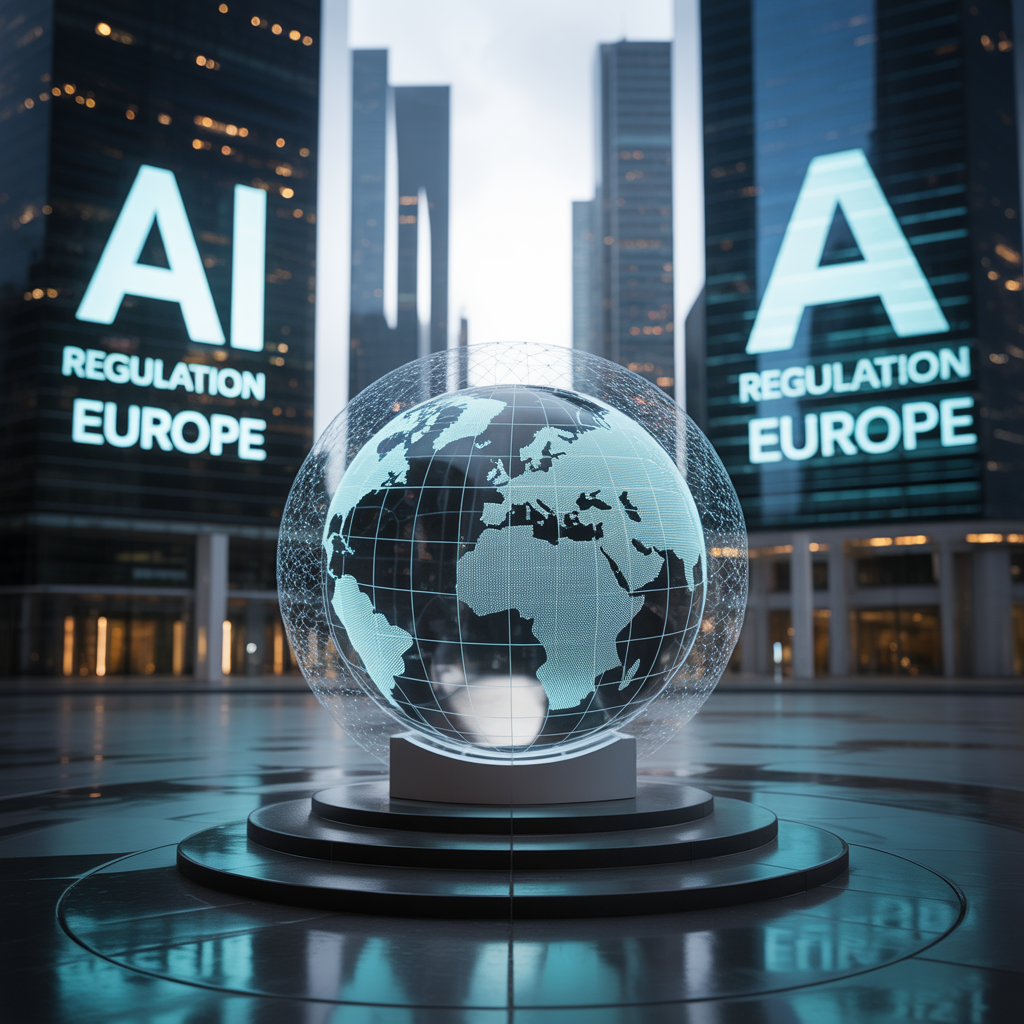Why Europe Is Lagging Behind in AI Innovation: The €270 Billion Gap Threatening Digital Sovereignty

The artificial intelligence race has become the defining technological battleground of our era, yet Europe finds itself trailing significantly behind the United States and China . Recent data reveals a staggering €270 billion annual investment gap between Europe and its global competitors, raising urgent questions about the continent’s digital future . While the US captures 61% of global AI funding and China rapidly scales its capabilities, European firms attract merely 6% of worldwide AI investment .
This disparity isn’t just about numbers—it represents a fundamental challenge to Europe’s technological sovereignty and economic competitiveness in the 21st century.
What Is Europe’s AI Innovation Challenge?
Europe’s AI innovation lag refers to the continent’s slower pace of artificial intelligence development, adoption, and commercialization compared to the United States and China. This encompasses everything from reduced venture capital investment and talent retention issues to regulatory complexity and infrastructure gaps that collectively hinder European AI companies from competing at the global scale .
The challenge manifests across multiple dimensions: only 11% of EU firms currently use AI, far from the bloc’s ambitious target of 75% by 2030 . At current adoption rates, projections suggest just 17% of European companies will integrate AI by the target date .
The Five Critical Factors Behind Europe’s AI Lag
1. The Massive Funding Gap
The most visible indicator of Europe’s AI challenge lies in investment disparities. Between 2018 and 2020, the overall AI investment gap between the US and EU more than doubled . While European AI startups raised $13.7 billion in 2024—representing 25% of all European VC funding—this pales compared to the $6 billion the US invested in AI development during the same period .
The European Innovation Council allocated just €256 million to AI development in 2024, highlighting the scale of the funding challenge . This creates a vicious cycle where European startups struggle to scale, leading to reduced investor confidence and further funding constraints.
2. Regulatory Complexity and the AI Act Dilemma
Europe’s regulatory-first approach to AI development has created both opportunities and obstacles. The EU AI Act, while establishing important ethical standards, has generated concerns among 50% of surveyed AI startups who believe it will slow innovation . The risk-based classification system, though providing regulatory clarity, adds compliance costs and complexity that smaller European startups struggle to navigate .
This contrasts sharply with the “move fast and break things” mentality prevalent in Silicon Valley and China’s rapid deployment strategies . European companies must balance innovation speed with comprehensive regulatory compliance, often extending development timelines and increasing costs.
3. The European Brain Drain Crisis
Europe faces a critical talent exodus, with many of the continent’s brightest AI minds relocating to the US, attracted by higher salaries, better-funded research labs, and more dynamic startup ecosystems . Countries like Germany experience hiring delays of up to 6 months for AI roles, while 80% of French employers report difficulty finding qualified AI talent .
The talent challenge extends beyond individual migration. Europe’s narrow definition of “high-skilled” talent excludes professionals upskilled through bootcamps and non-traditional pathways, limiting the diversity of its AI workforce . Additionally, while countries like Finland (39%) and Czech Republic (31%) show strong female representation in technical AI roles, this advantage diminishes at leadership levels .
4. Infrastructure and Geographic Misalignment
Europe’s AI infrastructure development faces significant geographic challenges. While the EU plans to establish 13 AI Factories across 17 Member States, research indicates that 10 of these facilities are not strategically located near existing AI talent pools . This creates substantial challenges for talent acquisition and retention, as each facility must develop custom attraction strategies while competing with other European hubs.
The infrastructure gap extends to computing resources. European companies often lack access to the massive computational power required for training large language models, forcing reliance on US cloud providers and limiting indigenous AI development capabilities .
5. Market Fragmentation and Scale Challenges
Unlike the unified markets of the US and China, Europe’s fragmented regulatory landscape across 27 member states creates additional complexity for AI companies seeking to scale . Different national implementations of EU directives, varying data protection requirements, and diverse market preferences force European AI startups to navigate multiple regulatory frameworks simultaneously.
This fragmentation particularly impacts growth-stage funding, where US investors increasingly dominate European AI rounds. Companies like Wayve ($1.05B), Mistral AI ($1.6B total), and DeepL ($320M) rely heavily on American venture capital to achieve scale .
Europe’s AI Success Stories: Signs of Hope
Despite these challenges, Europe has produced notable AI success stories that demonstrate the continent’s potential. Mistral AI stands as Europe’s flagship AI company, achieving a €6.5 billion valuation and developing competitive open-source models that challenge OpenAI’s dominance . Founded by former DeepMind and Meta researchers, Mistral has secured partnerships with major European enterprises and demonstrated that European AI companies can compete globally .
Other European AI champions include:
- DeepMind (UK): Google’s AI research powerhouse continues advancing fundamental AI research
- Stability AI (UK): Leading open-source generative AI development
- Helsing (Germany): AI defense technology with €5.3 billion valuation
- Aleph Alpha (Germany): B2B large language model development
These companies prove that Europe can produce world-class AI innovation when provided with adequate resources and strategic support.
The Path Forward: Europe’s AI Renaissance Strategy
The €200 Billion InvestAI Initiative
The European Union has launched the InvestAI facility, designed to mobilize up to €200 billion in AI investments . This initiative combines €50 billion in public funding with €150 billion from private investors, focusing on AI infrastructure, research, and startup development. The program includes plans for AI gigafactories—large-scale research and development hubs designed to advance Europe’s AI capabilities through open-source development .
Addressing the Talent Challenge
European policymakers are implementing targeted strategies to retain and attract AI talent. France’s recent €109 billion AI investment announcement signals political commitment to creating competitive conditions for AI professionals . The EU is also exploring expanded legal migration pathways for highly skilled workers and incentives for European AI talent to return from overseas positions .
Regulatory Innovation Balance
The challenge lies in maintaining Europe’s ethical AI leadership while fostering innovation. Recent policy discussions focus on creating “regulatory sandboxes” that allow AI companies to test innovative approaches within controlled environments before full compliance requirements apply . This approach aims to preserve Europe’s values-based AI development while reducing barriers to innovation.
7 Ways Europe Can Accelerate AI Innovation
- Establish Unified Digital Markets: Streamline regulations across EU member states to create a truly single market for AI services
- Increase Growth-Stage Funding: Develop European venture capital funds specifically targeting AI scale-ups to reduce dependence on US investors
- Create AI Talent Visas: Implement fast-track immigration processes for AI professionals and their families
- Build Strategic Computing Infrastructure: Invest in sovereign AI computing capabilities to reduce dependence on foreign cloud providers
- Foster University-Industry Partnerships: Strengthen connections between European research institutions and commercial AI development
- Develop AI Procurement Programs: Use government purchasing power to support European AI companies and create domestic demand
- Implement Flexible Regulation: Create adaptive regulatory frameworks that can evolve with technological advancement while maintaining ethical standards
FAQ About Europe’s AI Innovation Challenge
Q: How far behind is Europe in AI compared to the US and China?
A: Europe attracts only 6% of global AI investment compared to 61% for the US. The annual investment gap has reached €270 billion, and only 11% of EU firms use AI versus much higher adoption rates in the US and China.
Q: Is the EU AI Act hindering European innovation?
A: While the AI Act provides important ethical frameworks, 50% of surveyed AI startups believe it will slow innovation. The challenge lies in balancing regulatory compliance with innovation speed.
Q: What are Europe’s biggest AI success stories?
A: Mistral AI leads with a €6.5 billion valuation, while companies like DeepMind, Stability AI, and Helsing demonstrate European AI capabilities. However, these successes remain limited compared to US and Chinese AI ecosystems.
Q: Can Europe catch up in the AI race?
A: Yes, but it requires coordinated action across funding, talent retention, infrastructure development, and regulatory optimization. The €200 billion InvestAI initiative represents a significant step toward competitiveness.
Q: Why do European AI professionals move to the US?
A: Higher salaries, better-funded research environments, more dynamic startup ecosystems, and greater access to venture capital drive European AI talent to relocate to Silicon Valley and other US tech hubs.
Conclusion: Europe’s AI Crossroads
Europe stands at a critical juncture in the global AI race. While the continent faces significant challenges—from funding gaps and talent drain to regulatory complexity—recent initiatives like the InvestAI program and success stories like Mistral AI demonstrate that European AI innovation can compete globally when properly supported.
The next 24 months will prove decisive. As the US and China continue their AI arms race, Europe must leverage its strengths in ethical AI development, research excellence, and regulatory leadership while addressing fundamental weaknesses in funding, talent retention, and market fragmentation.
The question isn’t whether Europe can catch up in AI—it’s whether European leaders will make the bold investments and policy changes necessary to secure the continent’s digital sovereignty. What role do you think European values should play in shaping the future of artificial intelligence?
Sources:
Europe AI competitiveness analysis
BSA industry investment gap report
EU InvestAI initiative analysis
McKinsey Europe AI adoption study
Carnegie Endowment EU AI analysis
World Economic Forum digital transformation report
European Court of Auditors AI investment report
European AI startup funding analysis
EU-China AI investment comparison
Forbes EU AI Act impact study
Related Articles on ReadsToday:
- How AI Influences Your Daily Life
- Is AI Evil? Debating the Ethics and Dangers of Artificial Intelligence
- AI Innovations Dominate Google I/O 2025 Event
- Devstral AI introduces innovative coding LLM model
- Jony Ive Reshapes OpenAI’s Design Future
- How Quantum Computing Will Transform Everyday Technology
- AI Copyright Concerns: US Office Accuses Companies of Theft

